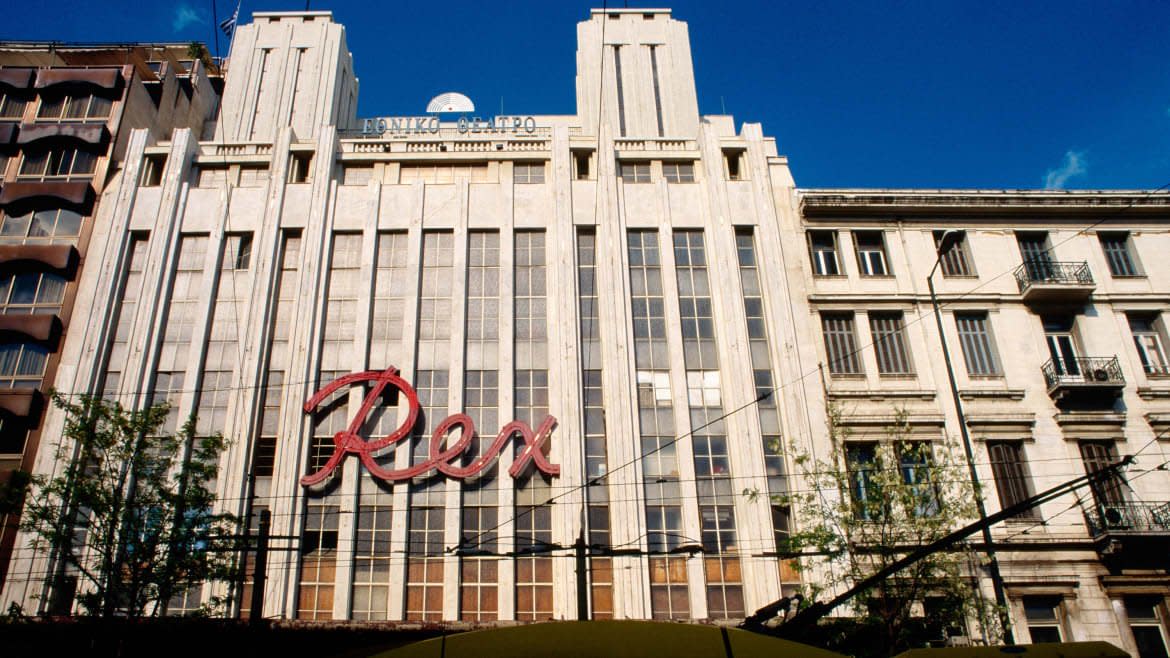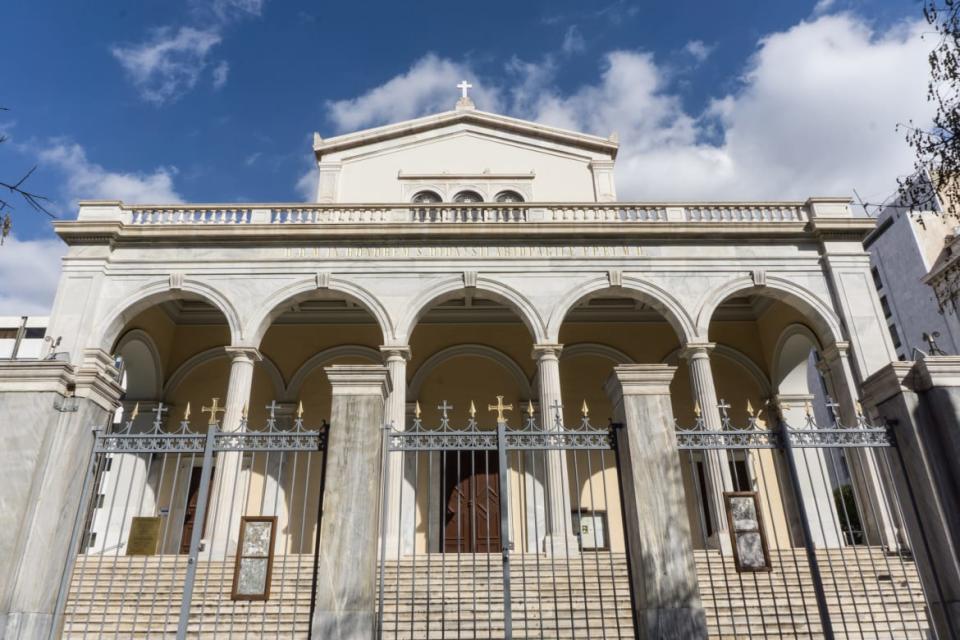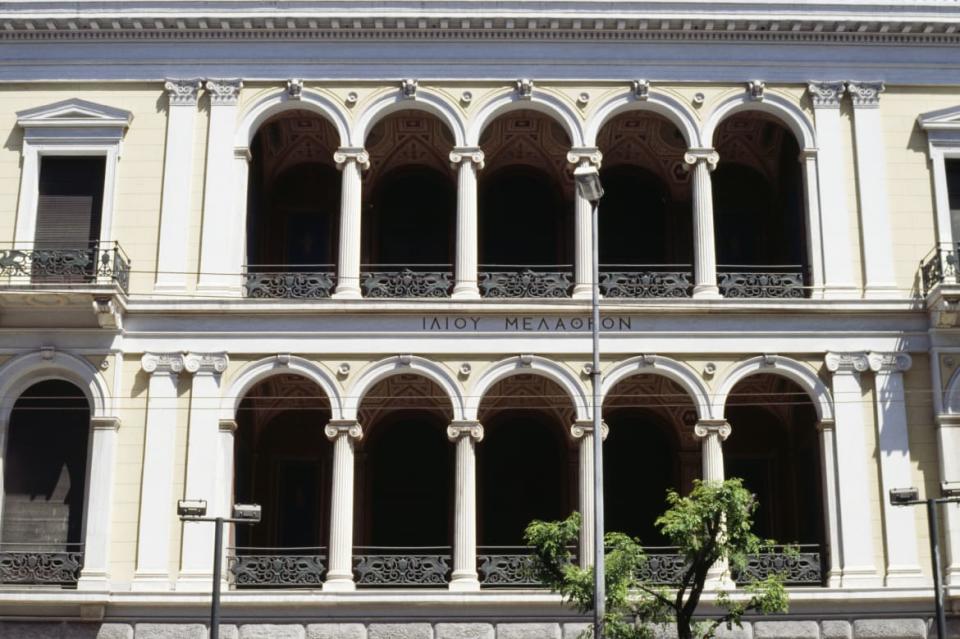Athens’ Architectural Heritage Is Slowly Slipping Away but These Heroes Are Saving It

One day in 2006, Irini Gratsia was walking through Athens and wondering why nothing was being done to save the city’s historic pre-War buildings. Although Greece has stringent archeological laws to protect antiquities, the city’s modern architectural heritage–which began in 1834 with the establishment of Athens as the capital of a newly independent Greece–has largely been ignored.
Popular images of Athens tend to depict it as a city of ancient ruins and modern apartment blocks with little in between, but take a walk round any neighborhood and you’ll find something of architectural interest—try central Panepistimiou Street, an urban museum and perhaps the most remarkable ensemble of modern architecture anywhere in Greece.
There are of course the Neoclassical buildings that defined the fledgling years of the Greek state, the earliest of these designed by architects spirited in from Germany and Denmark in order to re-imagine a post-Ottoman Greece based on a romanticized impression of ancient Athens. The movement reached its apotheosis with Theophil and Christian Hansen’s ‘Athenian Trilogy’ at the center of Panepistimiou Street, a lurid expression of romanticized philhellenism in architectural form. As Greek architects began learning the trade they developed a more subdued Greek Neoclassicism, as seen by the adjacent Serpieri Mansion (1881) by Anastasios Theophilas and the yellow Rallis House (1835) by Stamatis Kleanthis opposite, surreally reflected in the glass tower block behind. There’s also the Attica Department Store, a Neoclassical-Art Deco fusion and the largest building in Athens at the time of its completion in 1938, the Neobyzantine Athens Eye Hospital (1855), the Neorenaissance Numismatic Museum (1880), the Catholic Basilica of St. Dionysius the Areopagite (1865) with its ‘why not?’ fusion of Neo Byzantine, Neoclassical and Neo Renaissance, the New York-esque towers of the Art Deco Rex Cinema (1937) and the Stripped Classicism of the Bank of Greece (1938).

Serpieri Mansion
By World War II, Athens was one of Europe’s most beautiful and eclectic cities. But a post-War building law, now seen as reckless and short-sighted, incentivised homeowners to knock down their houses and replace them with identikit concrete apartment blocks. The state also took part, knocking down historic buildings to build somber gray-glass towers that continue to blight the city’s landscape. Other buildings collapsed of their own accord, the owners having abandoned them for the New World many years earlier.
The post-War building spree is often given as the reason for Athens’ oppressive concrete appearance. And yet, walking through Athens today, you can still spot these pre-War survivors. There are a surprising number of them, largely hidden, subsumed, and sometimes entombed by their concrete surroundings. But they’re still there, surviving.
“These buildings are part of the biography of our city,” says Irini, “Without them, you cannot tell the story of modern Athens.”
Realizing the state would do nothing, Irini assembled a small team of volunteers to comb every street of Athens, photographing and detailing every building built before 1940, regardless of their condition. “We didn’t even have a registry of historic buildings in Athens,” she says. “We had to make the registry ourselves.”
Today the organization she co-founded, Monumenta, has recorded over 11,000 historic buildings in Athens, and has helped save and revitalize around 50 of them—all without state help.
Recording buildings is one thing, saving them is another. “Demolishing listed buildings is something which unfortunately happens very often in Greece,” says Stelios Lekakis, an archeologist and co-founder of Monumenta. “So we needed to set up a system whereby people can call us if they suspect a building is in trouble.”
This kind of bureaucratic activism forms a large part of Monumenta’s work. “People come to us with tip-offs all the time,” says Stelios. “There are many cases where we were able to go to the court, get an injunction and then run —literally run—to stop the bulldozers in time.”
The group has a complicated relationship with the Ministry of Culture and the Archeological Council, whose methods are arcane and whose members are still referred to as ephors, an ancient Greek term meaning ‘overseer’, which doesn’t exactly help to dispel their gnomic reputation. “There are many good people working in the ministries, but the organization as a whole can be distant and obtuse,” stays Stelios. “I get the feeling they don’t like us very much because we’re doing things they should have been doing decades ago.”

Catholic Basilica of St. Dionysius the Areopagite
Then there is the tricky issue of ownership. Greece still has no official property register and it’s not often clear who owns a building. Such is the nature of inheritance in Greece that a single house might have multiple owners, spread across multiple continents, many of whom are likely unaware they are even owners.
One of the ways the group tried to solve this was simply to put leaflets through letterboxes, asking if anyone knew anything about their house or the houses around them. It was only when they started recording the stories of the tenants that they discovered a different Athens–one of memories, feelings, and histories that had been obscured by the city’s post-War development spree. From here, the project transformed from a simple architectural study into something much more profound.
The Monumenta office in the trendy Athenian neighborhood of Psyrri is a hive of activity. Young researchers meticulously clean the pages of century-old manuscripts, while others are busy creating Monumenta’s digital archive, which will include an online map of every historical building in Athens. You sense a real passion for their work. There has to be in Greece, where NGOs are a relatively novel concept and state institutions still use fax machines to communicate.
“In the past there was no consciousness towards these buildings. While the antiquities were seen as a symbol of our national identity, modern buildings were not seen as part of our heritage,” says Stelios. “They were seen as an impediment to modernity, which was apartment buildings, highways and cars.”
The group realized they needed to create a powerful social platform to raise the consciousness of citizens to the importance and value of preserving historic buildings, and to empower people to take an active role in the aesthetics of their city. After all, how can a program like this succeed, unless the people themselves want it?
“We want to be close to people,” says Irini. “So we started doing educational programs in schools, or coffee meetings with residents of historic buildings who can tell their stories. Recently we’ve begun organizing neighborhood tours, so locals can really see and appreciate what surrounds them.”
“The closer you get to buildings, the more you get to know them, they become like friends,” she adds. “You get that feeling of familiarity and friendship that counteracts the alienation that modern, concrete tower blocks can induce. They offer you an aesthetic quality that makes our lives beautiful.”
The program has expanded to other cities in Greece and Cyprus and has an active Facebook community, where people come to share photos and stories regarding historic buildings in their neighborhood. They are also developing a step-by-step guide to export to other countries in similar situations to Greece. “Try and group all creative resources that you might have,” says Stelios. “Start from a neighborhood or city center, then replicate it in bigger regions.”

Facade of Heinrich Schliemann's (1822-1890) house, now the Numismatic Museum, designed by architect Ernst Ziller
On one recent walk, Monumenta led a group of curious citizens around the neighborhood of Ampelokipoi. Sifting through the concrete, one area stood out: a series of three-storey, ochre colored apartment buildings known locally as the Prosfygika. Though not postcard pretty, they have a melancholic beauty which grows on you as you wander around and learn about their history.
Built between 1933 and 1935 by the architects Kimon Laskaris and Dimitris Kyriakos in a functional style inspired by German Bauhaus, they symbolize one of modern Greece’s most extraordinary chapters—the absorption and integration of over 1 million refugees who came to the country during the 1923 Greek-Turkish population exchange. The refugees in Ampelokipoi spent the first years of their arrival living in tents in a football stadium, before moving to the Prosfygika in the early 1930s. In December 1944, Prosfygika was the scene of vicious fighting between communist and nationalist forces in an early battle of the Greek Civil War—bullet holes are still visible on the walls.
Now mostly squatted, they are under constant threat of destruction due to their enviable location near the city center (Monumenta are keeping a close eye on them). And yet here they are: a living testament to a century of history. Hopefully, 100 years from now, these same buildings will still be here, to tell their story to a new generation.
Get the Daily Beast's biggest scoops and scandals delivered right to your inbox. Sign up now.
Stay informed and gain unlimited access to the Daily Beast's unmatched reporting. Subscribe now.

